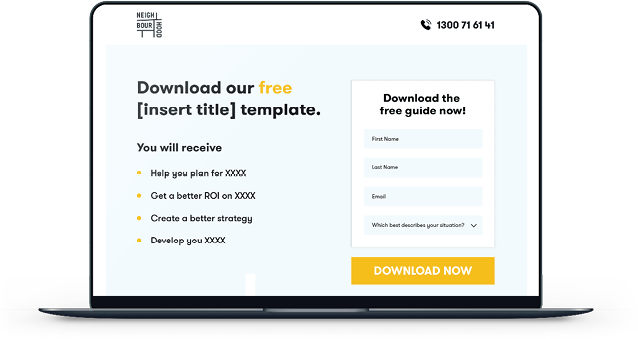The key to successful marketing is to go where your customers are, as a society we are glued to our phones and technology so as a marketer it makes sense to go digital, take your content directly to them or let them find you. In the modern era it is the most commonly practiced type of marketing and for good reason.

Traditional marketing is something we’re all familiar with and we see it every single day. Everything from TV and radio commercials to magazines, newspaper ads, billboards, that annoying telemarketing you cop as you sit down for dinner or sales fliers dropped in your letterbox. All this attention-grabbing stuff that has the goal of reaching every consumer, ANY consumer. You spend all this money on ad space hoping and praying that the right person sees it.
The biggest problem these days is we’ve become really good at blocking it out, everything from muting the television during the ad break to flicking between saved radio stations in your car. Traditional advertising is all about interrupting what a person was doing, grabbing their attention for half a second and almost immediately getting mentally filed into the ‘annnnyway, moving on’ pile. It’s all the same, these days and while it still has its place there are more effective ways of marketing.
Using traditional marketing makes it difficult to measure your ROI and you really can’t be certain the people seeing your content are the right people. Digital on the flip side has an abundance of tools that helps you target the right people, with the right content, at the right time.
We all have problems each and every day, ranging from “which burger challenge will I complete tonight?” (all of them) or to the very issue that brought you here, “what is digital marketing?” You aren’t driving around looking for a billboard or trawling every newspaper at the newsagency for an ad to help you solve these issues, you’re searching for the answers online.
Consumers search for answers on Google and it leads them to your blogs, e-books or videos that help them solve it. Solve their problem and they’ll find you.
Once upon a time, we didn’t have the wealth of knowledge that is the internet, so if the greasy salesman said so we had to believe him. It’s like every dodgy looking kebab shop claiming they’ve been voted the best kebabs in your city but who voted for this? You might have believed this back in the day but now you can just jump online and find that in fact, they’re lucky to be open with all those health violations.
We have access to more information than ever before so trust and credibility with a brand are more important than ever.
Traditional marketing strategies or outbound marketing are all about getting your product in front of the face of consumers whether it be billboards or television commercials etc. Inbound marketing turns this idea on its head and is a method of attracting, converting, closing and delighting people to grow your business so that it provides real value and trust with its consumers.
Inbound is about creating a valuable and unforgettable experience at each step of the way for potential customers so that they either follow through with a purchase or leave raving about you to their friends. It’s about transforming the way you market to match the way your customers purchase.
At the awareness stage, your prospect is aware they have a problem but they want to learn more. Here you would offer a no to low-risk offer where there is minimal commitment required from the consumer. An example of no risk is an ungated blog or pillar page (such as this very one you’re on now) and low risk is a downloadable e-book on the topic, where the prospect needs to register with their email to access.
If you’re out there searching for information on a topic then chances are you are interested in learning more so registering your email to receive content won’t be a big deal for you. Once you have a prospects email address you can keep sharing insightful and valuable content which builds trust and credibility with your brand.
The second stage is the consideration stage where the consumer has identified their problem and are now wanting to find and compare solutions. Here you would share case studies, blog articles that cover ingredients effects or how-tos. Give them the knowledge to make an informed decision.
The final stage is when the lead will be the most informed and armed with the tools they need to make a decision, hence the name, the decision stage. They are ready to chat directly with your sales team, they know what to ask, what to look for and now they want to know how much it will cost them. It’s time to seal the deal.
Search Engine Optimisation or SEO is arguably one of the most important aspects of digital. If you have high-quality, informative content and people can’t find it then what is the point?
There isn’t just one single key to ranking on search engines or nailing your SEO. If you make your website or blog as user-friendly as possible the better chance Google and search engines will rank your page higher.
Search engines look at absolutely everything from page load speeds to keywords, meta descriptions to image alt texts, unique content to site structure. All of these are important to have done correctly as they enhance user-experience and if they’re not right, they may penalise you.
Search engine ranking is a bit of a popularity contest with backlinks being widely considered one of the keys. They act as “votes” to tell the search engines that other pages out there think your content is thorough and your business is an expert on the topic.
It’s hard to deny the rise of social media over the last 10-15 years. It all started with MSN, having song lyrics in your bio to Myspace, choosing a theme song to your profile, evolving into what we have today with Instagram stories of every meal eaten worldwide to Facebook groups for every niche, Uni assignment group or sporting teams fans (a personal favourite of mine - Bronxnation).
Social media is a key arm of Digital marketing, it is your 1 to 1 communication channel with your leads and customers. They’ve got a problem, you can speak to them directly to solve it and support them.
A successful marketing campaign uses a variety of channels, you shouldn’t drop everything and focus 100 percent of your marketing efforts on social media however with 3.2 billion active users daily you can’t just ignore it.


There are limited clickable options on landing pages and the reason why is that if there are multiple options to click on a page you could move from page to page, eventually get bored or find what you need and leave. Landing Pages are designed to only have one purpose and goal. They are the guiding light for your prospects and you choose where it leads them by using a Call-to-Action (we’ll get to this soon).
Landing Pages are your beehive for generating leads and are the first step in how you segment leads and tailor your marketing so you can provide the right content to the right person.
There’s an example of a Call-To-Action or CTA right above this subtopic in “landing pages”. The “DOWNLOAD NOW” button is an example of a clear, simple CTA which prompts you to click it to do exactly as it says, download the checklist now.
A Call-To-Action is a prompt on a website, landing page or in an email that directs a potential customer to perform a desired action, usually in the form of a button or hyperlink. The wording on a CTA can be as simple as “BUY NOW” or “LEARN MORE” to a little longer in some cases with “Download our free guide to Inbound marketing here”.
The CTA is a key element on any webpage as it acts as a signpost that lets the user know what they should do next. It’s simple and that’s because they really are. If there is no CTA on a page you’re likely to leave the page without exploring more or taking an action. However, if there is a clear button or action to prompt your next move, chances are you’ll take it.Once you’ve mastered the basics through Hubspot you can even insert smart CTAs which will show a different wording to people you’ve segmented into lists. For example, the first time you’re on a page it says “LEARN MORE”, you click it, you learn more and then once you return again it says “BUY NOW” pushing you along the buyers' journey.
We’ve mentioned how important landing pages are to your lead generation strategy and now it’s time to unpack what lead generation is.
A lead is a visitor or prospect who has indicated some form of interest in your company, product or service you offer. Leads have begun their buyers journey and are showing signs they wish to make a purchase.
Lead generation is a strategy used in all types of marketing to attract and convert strangers and prospects into potential customers. In digital it's not about solely increasing traffic to your website, it's about increasing the quality of traffic.
Who is more likely to purchase from you? A person who has no knowledge of you, your product or how to address their issue or a person who’s actively shown interest in finding a solution? Attract people with answers to their solutions, not irrelevant services.
I personally know at 27 years old I’m not wanting funeral insurance phone calls ten times a day but if I’m actively searching for Footy tickets for this weekend I’m more than likely to open that email from the club to take them up on the offer
The most effective way to generate and qualify leads is through quality content, which we’ll get to next.

The relationship between content and marketing is clear but you’re probably asking why? Well for starters content marketing engages people. If done properly, it is written to make an impact on someone, to answer their questions or solve their issues. If you answer my questions there’s a good chance I’m going to be engaged and hang off your every word.
Secondly, it builds trust. Back to my previous point, you answer my question then there’s a strong chance I’m hook line and sinker and trust that you know what you are talking about. Will you purchase from somebody who can’t answer your problem or someone who can prove it and show you they are your knight in shining armour?
Thirdly, consumers are human too so we don’t just want to take the first thing that we see, we want a relationship before we commit to a sale, especially if it’s for a lot of money. Content helps build rapport without needing to be face-to-face. Show the consumer you can solve their issue and they’ll trust you enough to progress to the next step in the sales funnel.
-2.webp)
Worldwide there are an estimated 3.2 billion email users today and with ROI on email marketing approximately $38 for every $1 spent it’s hard to deny how effective it can be. It’s also worth noting that 90% of emails reach their intended destination while only 2% of your Facebook fans will see your posts. Absolutely mind blowing right?
The cost to send an email can be zero, absolute donuts. Anyone can open up a Gmail account for free and begin marketing their product, they just need a database to market to. This is why landing pages and CTAs are so important as they help you gather email information about people so you can contact them directly with the content they want to see.
There’s a difference between using email to market your product and effective email marketing.
Lead nurturing is essential to a good digital marketing strategy. You’ve got the lead on the line and this is how you keep yourself front of mind without being a crazy stalker ex-girlfriend (or boyfriend). Once they forget you the deal is closed so how do you stay in contact without being overpowering?
It’s all about relationship building and focusing all your marketing and communication on listening to the needs of your leads, and providing the answer they are chasing. The keys to lead nurturing is your timing, humanising your emails and creating useful content.
If you’re sending 10 emails a day you’re going to look a tad needy, send 1 email every 6 months and they may forget about you. You can humanise your emails by personalising them and addressing the recipient by their first name, which you can do with most good CRMs such as Hubspot. The final key is to create useful content which is completely up to you. If you understand your target audience and who you’re talking to this should be the easiest step of them all.
You should already know who your target audience is and you should be able to talk to them in a way you’ll know they’ll respond to. Use all the information you’ve gathered about them to keep your emails relevant and interesting which in turn should keep your leads engaged with your content.
Lead nurturing will not only help progress your prospects and leads through your sales funnel, but it will also increase the quality of the leads you attract and as they progress the more likely they will become customers which is the goal at the end of the day.
We’ve covered a lot of aspects of digital marketing and it’s quite a lot to take in but this is where it gets easier. If all the other parts are the keys to the digital marketing car then marketing automation is the wheels. It keeps you moving even when you’re not.
Marketing automation is the software that helps you communicate to leads and customers with the right content, at the right time. It’s designed to help you prioritize and execute your marketing tasks in a more streamlined and efficient way.
Automation isn’t like robots coming to steal your job and make you redundant, it’s designed to streamline your efforts to allow you to do more with what you’ve got.
As a marketer, you simply won’t have enough time in your day to manually lead nurture, to remind people to download your e-book or to personalise each and every email. For a business with 5 customers and 5 leads it’s absolutely doable without automation but the whole aim of digital is to attract more visitors, leads, and customers so once you grow it’s borderline impossible.
Imagine how much more you can do in a week if you could tick off half your to-do list automatically.
To work out how much you should be spending on marketing as a whole, you need to know and understand your customers. You’ll need to identify the average spend of your customers, do a lil math and work out their average lifetime spend. Or as it’s called, ‘Lifetime Value (LTV)’
Now that you’ve worked out how much one single customer is worth to you over their lifetime, you can work out how much you should be spending to acquire that customer. A general rule of thumb is that you should spend roughly 10 percent of a customer’s LTV on acquiring them (or on marketing to them).
